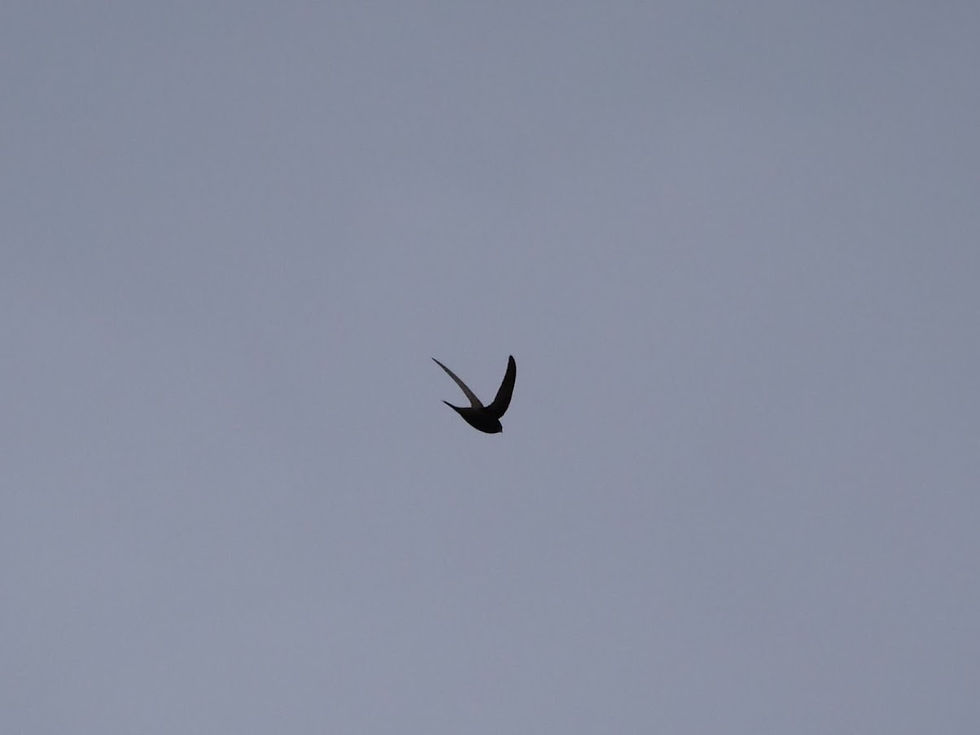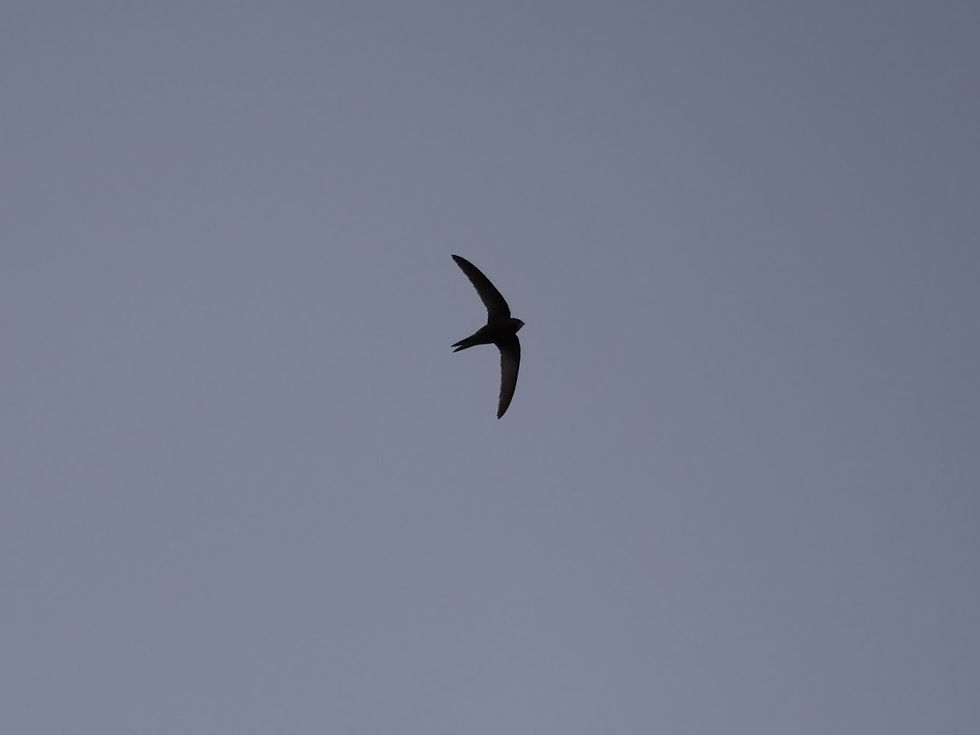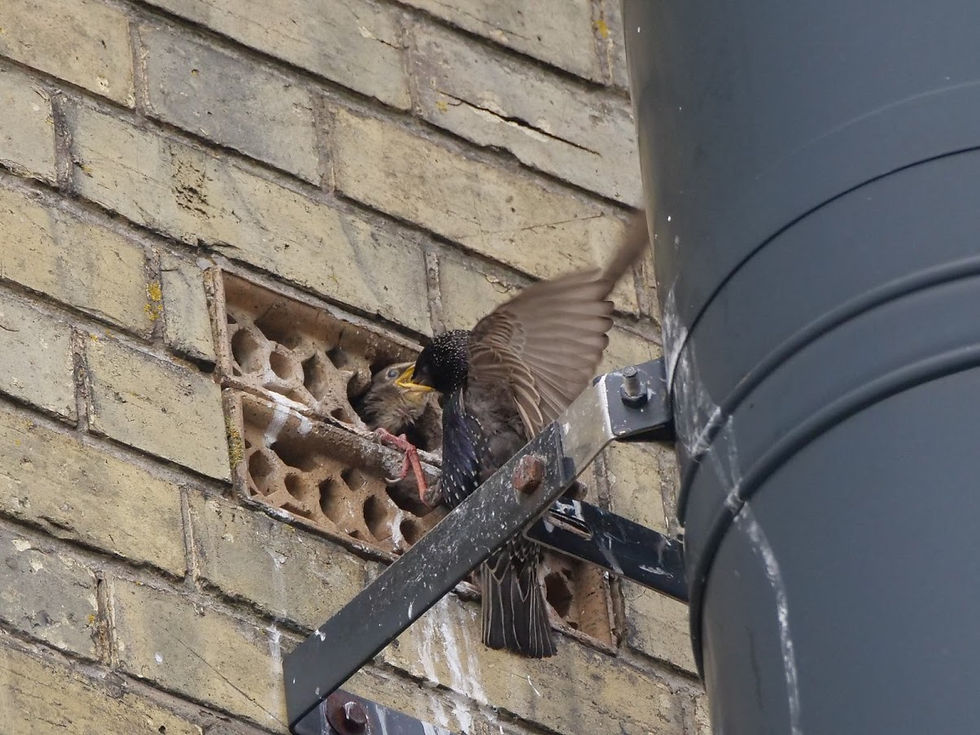Swifts - Brighton General Hospital - Observation 1 - 11.05.21
- Sim Elliott
- May 16, 2021
- 6 min read
We saw ca. 10 Swifts fling above the hospital blocks, but no Swifts entering or leaving nest sites. I photographed 3 Swifts in flight above the hospital blocks.



We also so a Starling feeding a chick in a space (air brick) that may formerly have been a nest site for a Swift.

Amazing facts about Swifts - Amazing facts about swifts (rspb.org.uk)
Swifts around the world
Our swifts and its relatives form a group called the Apodidae - this is a very ancient group. They probably separated from all other birds in the Tertiary period (65 million years ago) or even the Cretaceous (70mya). Archaeopteryx was 150 mya, and Tyrannosaurus died out about the same time as the Apodidae separated!
• The earliest known swift-like bird, Priamapus lacki, was named after David Lack, the ornithologist who did the most work on swifts.
• Our swift’s closest living relatives are other swifts, swiftlets and tree swifts (which can perch) and the hummingbirds.
• As a group, swifts are the fastest of all birds in level flight (the peregrine is the fastest of all birds, but only in a steep dive called a stoop). Our swift holds the record for the fastest proven. (Henningsson et al How swift are swifts? J Avian Biol 2010 41: 94-98). The top speed recorded in a recent scientific study was 111.6km/h (69.3mph). The needle-tailed swift of Africa and Asia has been reported to reach 170 kph, 105mph, but this is not proven.
• The birds vary geographically. Swift species tend to be paler in drier and darker in wetter areas, and tend to be smaller in hotter and larger in colder regions. The further north a swift species lives, the darker it will be – and ours are the darkest of the lot
• Of the three species of swift breeding in Europe, the one with the most southerly breeding range (the pallid swift) has the most northerly winter quarters, while the one which breeds furthest north in Europe moves furthest south in Africa – ie our swift. David Lack’s swifts travelled over 6000 miles to reach S Africa.
• One reason it’s hard to know much where they are and what they’re doing in winter – they look so like other swift species, especially the African black swift, that it’s hard to tell which is which without catching them – not easy to do.
Our very own swift
• Our’ swifts are only ‘British birds’ for a quarter of their lives (three months per year) – the rest of the time they’re African
• They have soft beaks – but very powerful feet
• Their four toes are arranged in twos, each pair pointing sideways rather than forwards, a bit like a chameleon or a koala.
• The wings are long and narrow, and superbly adapted for fast flight, but don’t allow slow flight or a great deal of manoeuvrability
• In flight the forked tail is closed to a point for extra efficiency
• A swift weighs about the same as a Cadbury’s Crème Egg, Crunchy (or any other 40g chocolate bar)
• For its size, the swift has an exceptionally long life-span – averaging about 5.5 years. One bird in Oxford was found dying in 1964, 16 years after it was ringed as an adult, and therefore likely to be at least 18 years old. It’s reckoned that this bird flew, in its lifetime, about 4 million miles, the same as flying to the moon and back 8 times!
• In swifts generally, longest primaries can be up to three times the length of the secondaries – only up to twice in hirundines (swallows and martins).
• Eyes are deep seated and have moveable bristles in front – sunglasses for reducing glare.
• All birds have fleas and feather lice or similar parasites. However the swift’s are so different to those of other species that it supports the fact that they separated from other bird species a very long time ago. Their parasites have evolved with them.
• Swifts were once thought to hibernate over winter – like swallows, which were believed to hibernate in mud below ponds. Even the naturalist Gilbert White in mid 18C got labourers to dig up likely spots to see if he could find any. He heard tales of swifts being found alive but torpid in church towers in early spring.
• Edward Jenner, he who invented vaccination, marked several swifts by cutting off toes and noticed that they re appeared in the same place the next spring. He was convinced that they’d migrated – and in evidence noticed that the re-appearing birds were fat and in excellent condition
• They almost never land – except at their nest sites – doing everything on the wing
• A healthy adult swift can get off the ground but rarely needs to. Starving young ones usually can’t and these are the ones most often seen.
• They can sleep on the wing – a French Airman in the 1914-18 war glided down with engines off behind enemy lines. At 10,000 feet he found himself amongst birds apparently motionless. One of them was caught in the machine on the following day was found to be an adult male swift.
• Not many predators can catch a swift – hobbies may take a few, and so may kestrels, tawny owls and barn owls. However, it’s likely that many of the swifts they manage to eat were weak for other reasons eg starvation. Very few mammals ever catch one, except perhaps rats or weasels that can climb to nests.
• They seem to bathe by flying relatively slowly through falling rain.
• In Tuscany people used to eat young ones, even building special towers to house them – the swift equivalent of a dovecot. Apparently they are delicious! Don’t try this at home…
Eating and drinking
• The swift probably eats more species of animals (small insects and spiders) than any other British bird. David Lack recorded over 312, and reckoned there were more. They usually take items 2-10mm long.
• They probably hunt at about 25 miles an hour
• They drink by gliding over smooth water and taking sips
• Swifts can be quite selective about what they catch. One was found to have caught only stingless drones around bee hives, and to have neatly dodged all the females, which had stings
• Swifts can’t feed in wet weather in the UK, so fly around storms to find dry areas – the only UK birds to do this.
• On the wintering grounds in Africa it’s different – there are more insects in the air on rainy days, so the swifts will head for rain.
Bringing up baby
• It seems they really can mate on the wing – but they will also mate in their nest holes. No other bird is known to mate on the wing (apart from some other swift species)
• Use saliva for nest building – like the edible nest swifts
• Nesting material is collected on the wing (it has to be) so they can only use what they can find in the air – David Lack once recorded them using a live butterfly!
• The weight of an egg is about one-twelfth the weight of the female that laid it approx 3.5 grams
• Even the experts agree – very young swift chicks, before they get their feathers through, are hideous!
• They have a clever adaptation. Food can be scarce in bad weather – the chicks can go cold and torpid and survive for days without food, then regain weight rapidly once supplies resume. Most baby birds can’t do this and would simply die within hours.
• Only one other kind of bird can lose temperature control and become torpid each night – the hummingbird. This saves energy.
• The length of time the babies spend in the nest will vary, depending on how good the food supply has been, and can vary by up to three weeks – this is different to birds like robins and blackbirds which leave when they are a certain age, no matter how well they’ve grown.
• Each bolus (ball of food) brought to the babies weighs just over a gram, and contains 300 – 1000 individual insects and spiders. The average is 300-500 food items per bolus
• Swifts in the nest, especially the young ones, are bothered by horrifying parasites called louse flies (also called flat flies or keds). These alarming wingless parasites don’t actually seem to do them any harm but they are relatively huge, and are roughly equivalent to us having 10 cm lobsters or crabs crawling on us! Each blood meal these things take from a swift is roughly the same as we would give in one-quarter of a blood donation. Louse flies may look scary but they are no bother to people and very rarely bite.
• At about a month old, the babies do ‘press ups’ in the nest, lifting themselves up by pushing down on their wings, probably to strengthen the wings. By the time they’re ready to go, they can hold their bodies clear of the ground like this for several seconds
• Once they launch themselves off on their very first ever flight, that’s it, they don’t return to the nest and are no longer cared for by the parents.
• Unlike many birds, the siblings do not necessarily leave together – each goes in its own time, when it’s ready. And it may well head off to Africa almost straight away
• Breeding pairs sleep in their boxes – it appears to be the young non-breeders that spent the night up in the dark
Kommentare